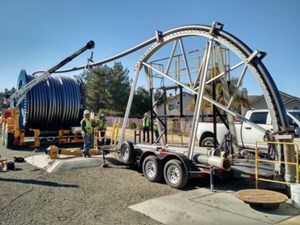DOE awards $34 million for advancing underground power line technologies
(UI) — The U.S. Department of Energy (DOE) has awarded $34 million for 12 projects across 11 states to strengthen and modernize America’s aging power grid through the development of cost-effective, high-speed, and safe undergrounding technologies.
Through the Grid Overhaul with Proactive, High-speed Undergrounding for Reliability, Resilience, and Security (GOPHURRS) program, the selected projects will advance innovative solutions to help upgrade and expand the nation’s grid infrastructure—lowering costs, reducing inefficiencies, mitigating disruptions from extreme weather events, and accelerating the adoption of renewable clean energy resources.
“Modernizing our nation’s power grid is essential to building a clean energy future that lowers energy costs for working Americans and strengthens our national security,” said U.S. Secretary of Energy Jennifer M. Granholm. “With today’s announcement, DOE is supporting teams across the country as they develop innovative approaches to burying power infrastructure underground—increasing our resilience and bringing our aging grid into the 21st Century.”
The electric power distribution system in the U.S. has over 5.5 million line-miles with over 180 million power poles, all of which are susceptible to damage by weather and its effects, and account for a majority of power outages in the country each year. Climate-change fueled extreme weather events are increasing the frequency and intensity of power outages across the U.S., harming communities and disrupting livelihoods. Undergrounding power lines is a proven way of improving the system reliability for both transmission and distribution grids as weather events are less likely to interfere with systems that are protected below ground.
Managed by DOE’s Advanced Research Projects Agency-Energy (ARPA-E), the teams announced today—including small and large businesses, national labs, and universities—will play a critical role in developing technologies to reduce costs, increase speed, and improve the safety of undergrounding operations. Selected projects include:
- Arizona State University (Tempe, AZ) will develop a water-jet underground construction tool that would deploy medium-voltage electrical cables and conduits simultaneously underground with a lower risk to existing utilities by eliminating the need for a hard drill bit—reducing cost and lowering schedule impacts from reaming and duct pulling tasks. (Award amount: $4.3 million)
- GE Vernova Advanced Research (Niskayuna, NY) will develop a robotic worm tunneling construction tool that would dig and install conduit and cables for underground distribution powerlines in a single step. GE’s system would mimic the natural movement of earthworms and tree roots to install 1,000 feet of cable and conduit in two hours with unmatched flexibility. The tool could deploy from a standard pickup truck and would eliminate the cost, complexity, and surface disruption compared with conventional approaches. (Award amount: $3.7 million)
- Melni Technologies (Twin Falls, ID) will redesign and develop medium-voltage power cable splice kits that require fewer steps and streamline connections to greatly reduce human errors and boost the reliability of underground electrical power distribution systems. Melni’s proposed kits could be installed in 10-15 minutes, which is 3-4 times faster than conventional kits, and would reduce failures and mistakes up to 90% by eliminating installation steps and potential human errors. (Award amount: $2 million)
- Oceanit (Honolulu, HI) will develop a look-ahead subsurface sensor system—capable of sensing what lies beyond a drill bit--that would take advantage of unmanned aerial vehicles and electromagnetic resistivity techniques to avoid damaging existing utilities when undergrounding powerlines. The system would use machine learning interpretation and high-resolution imaging capabilities to provide real-time guidance for the drill path. (Award amount: $3.3 million)
- Pacific Northwest National Laboratory (Richland, WA) will develop an artificial intelligence system for processing geophysical survey data into digital twin—a model of a real-world physical product—and augmented reality in order to identify existing utilities and other subsurface obstacles before installing underground power distribution lines. Analysis, visualization, and reporting typically takes weeks or months after data acquisition, but the proposed system could produce results within minutes, providing near real-time subsurface mapping and utility identification which will lead to cost savings and speeding up of burying power lines. (Award amount: $3.75 million)
- Prysmian Cables and Systems USA (Highland Heights, KY) will develop a hands-free power cable splicing machine operating in underground vaults to reduce the share of splicing-caused medium-voltage network failures from 60-80% to less than 5% and dramatically improve the workforce safety by reducing the time the underground cable splicing crews spend in underground vaults. (Award amount: $4.5 million)
Related News
From Archive

- Glenfarne Alaska LNG targets late-2026 construction start for 807-mile pipeline project
- U.S. water reuse boom to fuel $47 billion in infrastructure spending through 2035
- $2.3 billion approved to construct 236-mile Texas-to-Gulf gas pipeline
- Major water pipe break in Puerto Rico hits over 165,000 customers
- Potomac River Tunnel project enters construction phase beneath Washington, D.C.
- Pennsylvania American Water launches interactive map to identify, replace lead water service lines
- Trump's tariffs drive $33 million cost increase for Cincinnati sewer project
- Utah city launches historic $70 million tunnel project using box jacking under active rail line
- Tulsa residents warned after sewer lines damaged by boring work
- Fatal trench collapse halts sewer construction in Massachusetts; two workers hospitalized




Comments